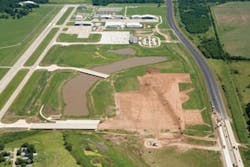Building Relief in Houston
In 1991, the City of Sugar Land acquired the private Hull Field as part of an aggressive economic development initiative that attempted to integrate planning with the urban sprawl coming from the nation’s fourth largest city. Seven years later, the city hired Phillip W. Savko as the airport development manager. His charge: develop a business plan that would provide a long-term vision for the role the airport would play in the community. Today, Sugar Land Regional Airport has become the key business aviation reliever west of Houston, a region traditionally dotted with small private airports. The city is now in Phase 2 of its business plan for the airport - it recently opened a 20,000-square foot terminal and is constructing a 100-space T-hangar complex. Next up: development of non-aeronautical properties.
Explains Joseph Esch, economic development director for Sugar Land, "The city has two economic development corporations. One has helped provide loans for the control tower and the corporate hangar. "The city has long held the belief that the airport and economic development are closely tied together."
In less than ten years the city has been able to transform the airport, with significant financial support from the Texas Department of Transportation and the Federal Aviation Administration. In all, according to the airport, $41 million in federal and state grants has been invested at Sugar Land Regional, including an FAA grant that provided 90 percent of the $18.5 million purchase price for the facility.
Today, Savko, who previously served as the No. 2 at Naples (FL) Municipal, is the aviation director and in 2001 was named the Reliever Airport Manager of the Year by TxDOT. "There was an opportunity here," explains Savko. "The city gave me a charge and then let me run with it." Sugar Land Regional has one 8,000-foot runway, which is longer than any runway at Houston Hobby Airport, the original Southwest hub.
According to Savko, some in the community would like to see commercial airline service here at some point, though the focus today is on accommodating current tenants and attracting business aircraft.
The airport has some 170 based aircraft, including 37 business jets, according to Savko. Major tenants include Western Airways (a charter/ aircraft management firm), Anson Air flight training, and Solapp avionics.
The city provides fueling – for which it maintains exclusive rights – and line services. Explains Savko, "The city decided to continue what was already in place when it acquired the airport and provide the services. It gives us the ability to take those earnings and reinvest." He reports that fuel volumes, which had been averaging some 170,000 gallons a month, have been rising since the opening of the new terminal, a record 246,000 gallons were sold in September.
Property taxes generated at the airport are returned to it by the city, bringing in some $200,000 annually. According to Savko, annual operating revenues are $10 million and operating expenses $8 million. "We’re able to cover our debt service plus put $400,000 annually into our corporate development fund."
The airport has constructed one corporate hangar and is currently constructing its second. With the new general aviation T-hangar complex, Savko says that he sees light aircraft and bizjets naturally migrating to opposite ends of the airfield.
The airports will offer 30-year leases with 25-year options on its new hangars, at a minimum rate of 27.5 cents per square foot, says Savko. The airport has U.S. Customs services on site, for which it pays an upfront annual fee and then recovers its costs. The airport is building a facility for Customs, expected to be completed in 2007.
Savko says there are nearly 426 acres available for development, including outside-the-fence property for potential hotel and retail development.
